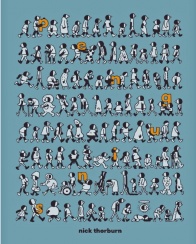A collection of strips that offers playful reflection of human life through animals that are simultaneously funny and sad – people aspire to a lot but achieve very little. It’s a book that appears to be significant but, once one looks deeper, appear to miss its mark.
Written, illustrated and lettered by Nick ThorburnCover by Nick ThorburnTold almost entirely without words, Penguins is one of the most playfully original graphic novels in recent memory. As author Nick Thorburn explains, “Penguins go through a lot of hell that could be avoided if they had the ability to fly. This cruel irony lends itself to humor, as well as sadness. Death and the desperate search for love and companionship seem so tethered to life as a penguin, as well as for humans, and so the goal was to bridge those two and make them funny.”
Relying on visual expression and the physical movement of his penguin characters, as well as the formal properties of sequential drawings (with penguins routinely moving within and without each page’s panel borders), Penguins is a series of interconnected short strips that, without words or human characters, does more to showcase the breadth of emotion we as humans experience than most prose novels.
There’s a strip somewhere towards the middle of “Penguins” which kind of sums up my problem with this book: it takes only one page and it shows a child engaging in the sort of cruelties one would expect to see in juvenile delinquents in 1950’s comics – kicking a dog, harming a fellow child, manhandling granny and pissing on food (I’m as lost as you are regarding the last one), but then he looks at him clock in alarm and kneels in prayer with a halo above his head and look of utter naivete upon his face. And scene.
If this is meant to be a critique of sanctimonious religious types who engage in ungodly behavior while extolling the name of god, well – it’s not a very nuanced criticism, nor an original one. It’s the sort of thing that would appear overdone in the 1960’s, let alone nowadays (not that I am against the idea – just against the way it is expressed). There’s a sense flowing all over this mighty tome of regression; if you told this collection came out in the 1990’s I wouldn’t be shocked: with the men pictured as mostly pathetic losers, obsessed either with trivial pursuits or with women who are too good for them.
Speaking of the tome being mighty: the solicitation text for this graphic novel, and as a collection of strips with little connective tissue this might not be the right term for it, promises to “showcase the breadth of emotion we as humans experience[.]” but the biggest problem with “Penguins” is exactly how one-note it feels, in terms of conveyed emotions – there’s hardly any hope, joy, love or fun to be found, it’s mostly a collection focused on sadness and pain and misery. According to this book the breadth of human emotion is actually pretty narrow, we suffer in the hands of gods who either don’t care or, alternatively, get a kick out seeing us fail. There’s another one-page scene with a man escaping form unknown pursuers into an empty panel only to crash into its side in the next movement. It’s the type of thing the Road Runner would do to Wile E. Coyote, rushing into a painted hole in the wall only to crash into it, only there’s no Road Runner figure here, we are all the dumb Coyote running into a wall.
This focus on mood is not a necessarily bad thing, if only “Penguins” wasn’t nearly 300 pages’ long, by the halfway point of this rather quick read I had to take a break because I felt as if the book was hitting me over the head – repeatedly making the same points with little variance in emotional texture. I think this is the kind of thing I would’ve enjoyed more if it was presented in a serial fashion rather than crammed in all at once, the book formats highlights the cons the work while detracting from the pros.
Continued belowWhich is shame because in terms of presentation the book is rather striking: Using the extra space of the many (many pages) Nick Thorburn plays with length and size of the strips, some taking just one-page other stretching over half-a-dozen; there’s some really funny (in a mean sort of way) gags here, playing with audience expectations in both plot and art levels. Thorburn’s intentionally simple style here lends itself well to playing with figures, twisting them in different ways.
I’ve mentioned Loony Tunes before and the book does have the gag-making strength of these early classic cartoons – bending reality to its whims, but always in interesting manner. Even if the mood of the work is rather singular the book carries well on the strength of the art.
If it seems like I’m coming down hard on this book it’s only because it seems like it could’ve achieved so much more with a little editorial assistance, pushing the writer-artist outside what appears to be his comfort zone. Nick Thorburn is obviously not lacking for talent, I just wish it was pointed at a better direction.




